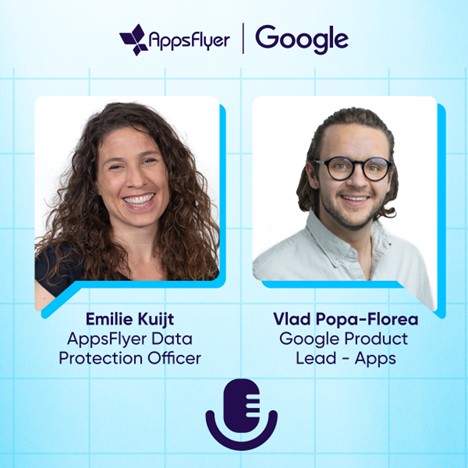
Navigating the privacy frontier: Key insights from Google and AppsFlyer

With consumer demands for greater privacy, seismic regulatory shifts, and the accelerating pace of technological change, the digital advertising landscape is undergoing its most dramatic transformation in decades. What will become of established practices, and how can advertisers navigate this new frontier while maintaining effective campaigns?
“We’re in a pivotal moment of advertising where AI advances are launching new opportunities for marketers, while regulatory and platform changes continue to emerge. Consumers are asking for more transparency and greater control over how their data is being used.”
This insight from Google’s Global Product Lead for Apps, Vlad Popa-Florea, sets the tone for a crucial conversation about the state of digital advertising. In a candid discussion with AppsFlyer’s Data Protection Officer, Emilie Kuijt, they explored how the marketing ecosystem is being reshaped by accelerations in AI, regulatory changes in the privacy landscape, and evolving consumer expectations. Together, these industry veterans offer complementary perspectives: Emilie brings years of experience helping companies navigate privacy regulations while balancing personalization needs, while Vlad provides insider insights on how one of the world’s largest advertising platforms is supporting marketers to adapt to these changes. The two explore some practical strategies on how advertisers can thrive in this privacy-first era:
Here are five key insights from their conversation:
1. Privacy as a Growth Enabler
Both experts emphasized that respecting consumer privacy is not just a compliance necessity but an opportunity. Advertisers can achieve growth while maintaining user trust by adopting privacy-first strategies. The industry’s move toward privacy-enhancing technologies (PETs), such as data clean rooms and contextual advertising, demonstrates this balance.
2. Preparing for 2025: A Turning Point
The year 2024 marked another inflection point for digital marketing. Through an increasingly fragmented ecosystem filled with evolving regulations, advertisers must prioritize resilient solutions. Google and AppsFlyer are committed to supporting advertisers with myriad tools and resources to navigate these changes.
3. The Balancing Act: Privacy vs. Personalization
Consumers want privacy but also expect relevant, personalized experiences. This paradox requires advertisers to find innovative ways to use minimal data while delivering tailored ads. PETs and secure, advanced AI-driven tools can bridge this gap, ensuring user preferences are respected without sacrificing ad relevance.
4. Consent is King
Consent management is a cornerstone of privacy compliance. Advertisers operating in many jurisdictions, including the European Economic Area (EEA), are often bound to secure user consent and relay it to platforms like Google. AppsFlyer’s integrated SDK simplifies this process, enabling seamless compliance while maintaining robust user experiences.
5. Future-Proofing with Collaboration
The discussion highlighted the importance of partnerships between tech leaders like Google and AppsFlyer. By aligning on privacy-focused innovations such as Privacy Sandbox and enhanced attribution models, these collaborations aim to future-proof advertising strategies in a rapidly evolving landscape.
What’s Next?
Advertisers need to act now by:
- Constantly evaluating and implementing privacy-enhancing technologies.
- Staying informed about regulatory updates and platform changes.
- Leveraging tools like Google Consent Mode and solutions embedded in AppsFlyer’s privacy-by-design SDK to streamline compliance.
This collaborative approach ensures advertisers can adapt to the new normal, combining user trust with marketing effectiveness. Together as an industry, we can navigate the privacy frontier with confidence and innovation.




